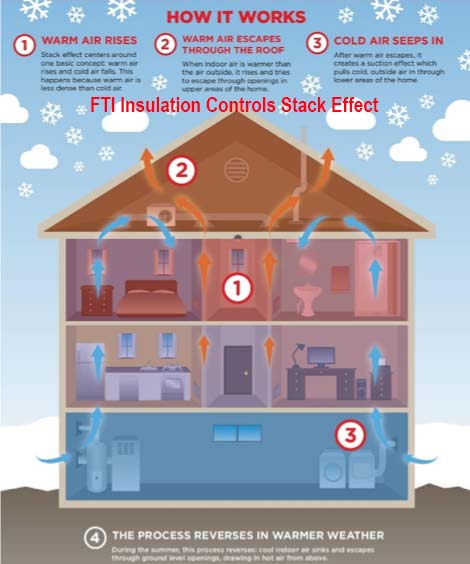Learn About Stack Effect To Improve Home Insulation
 Research has shown that approximately 30% to 50% of energy used for heating and cooling is lost due to air leakage. One of the primary driving forces for air leakage loss is a phenomenon where air flows within and through the building called stack effect.[i]
Research has shown that approximately 30% to 50% of energy used for heating and cooling is lost due to air leakage. One of the primary driving forces for air leakage loss is a phenomenon where air flows within and through the building called stack effect.[i]
Stack effect is generated by the difference in the air pressure created by temperature variation. For example, during the winter, warm air is less dense and lighter than cold air outside, so the warm air inside the building rises up and exits the building while drawing the cold air into the building through the leaks near the bottom of the building. During the summer, hot exterior air enters through the same air gaps near the bottom of the building and forces the air-conditioned air up through the ceiling and out of the building.[i] [ii]
Compared to fiberglass, properly installed products, such as FTI’s FIBER-LITE, function as a more efficient and cost-effective method to prevent the stack effect within a building. FIBER-LITE can be applied in both wall and attic applications to create a seamless insulated layer throughout the building.
Contact FTI to learn more about Stack Effect and how to control it in homes and buildings.
[i] Straube, J. (2012). PA-1203: Air Leaks-How They Waste Energy and Rot Houses. Building Science Corporation. Retrieved from: https://buildingscience.com/documents/published-articles/pa-air-leaks-how-they-waste-energy-and-rot-houses/view.
[ii] Assured Insulation Solutions. (2018). Stop Stack Effect For A More Comfortable Home. Assured Insulation Solutions, LLC. Retrieved from: https://www.assuredinsulationllc.com/blog/stop-stack-effect-more-comfortable-home.
[i] Straube, J. (2007). BSD-014: Air Flow Control in Buildings. Building Science Corporation. Retrieved from: https://buildingscience.com/documents/digests/bsd-018-the-building-enclosure_revised
